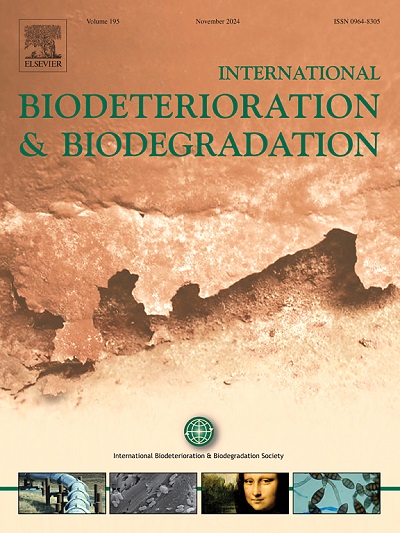Distinct responses of aerobic and anaerobic soil microbial community structure and function to anthracene stress at environmental contamination levels
IF 4.1
2区 环境科学与生态学
Q2 BIOTECHNOLOGY & APPLIED MICROBIOLOGY
International Biodeterioration & Biodegradation
Pub Date : 2025-03-24
DOI:10.1016/j.ibiod.2025.106074
引用次数: 0
Abstract
Anthracene (ANT) is widespread in terrestrial ecosystems, yet its impact on soil microbial community structure and function under varying oxygen conditions remains inadequately characterized. This study evaluated the responses of bacteria to ANT stress at environmental concentration (1.0 mg kg−1) under aerobic and anaerobic soils. ANT contamination enriched potential polycyclic aromatic hydrocarbons (PAHs) degrading bacteria, such as Actinobacteriota, Prolixibacteraceae, and Nitrosomonadaceae, under both aerobic and anaerobic conditions. It also resulted in the proliferation of oligotrophic microorganisms under anaerobic condition. Additionally, ANT promoted the functions related to soil carbon, nitrogen and sulfur element cycling functions (Wilcoxon rank sum test, P < 0.05) and altered microbial carbon source utilization preferences in aerobic environment. However, under anaerobic conditions, ANT inhibited soil microbial element cycling, resulting in adverse effects. Furthermore, label-free proteomics quantitative analysis was conducted for aerobic treatment groups, revealing that the ANT contamination in soil altered the growth, metabolism and reproduction of bacteria. Up-regulated proteins were mainly concentrated in the Kyoto Encyclopedia of Genes and Genomes pathways related to amino acid and energy metabolism, which generated energy to satisfy physiological demanding under ANT stress. These results indicate that ANT at environmental contamination levels exhibit varying microbial effects under different oxygen conditions. Therefore, it is crucial to consider both its concentration and soil redox conditions when assessing the risk of PAH compounds.
环境污染水平下好氧和厌氧土壤微生物群落结构和功能对蒽胁迫的不同响应
蒽在陆地生态系统中广泛存在,但其对不同氧条件下土壤微生物群落结构和功能的影响尚未得到充分研究。本研究评估了好氧和厌氧土壤中细菌对环境浓度(1.0 mg kg - 1)下蚂蚁胁迫的反应。在好氧和厌氧条件下,ANT污染富集了潜在的多环芳烃(PAHs)降解细菌,如放线菌科、Prolixibacteraceae和Nitrosomonadaceae。它还导致厌氧条件下低营养微生物的增殖。此外,ANT促进了与土壤碳、氮、硫元素循环相关的功能(Wilcoxon秩和检验,P <;0.05),改变了好氧环境下微生物对碳源的利用偏好。但在厌氧条件下,ANT会抑制土壤微生物元素循环,产生不良影响。此外,对好氧处理组进行了无标记蛋白质组学定量分析,发现土壤中蚂蚁污染改变了细菌的生长、代谢和繁殖。上调蛋白主要集中在与氨基酸和能量代谢相关的京都基因基因组百科通路中,这些通路在ANT胁迫下产生能量以满足生理需求。这些结果表明,环境污染水平下的蚂蚁在不同的氧条件下表现出不同的微生物效应。因此,在评估多环芳烃化合物的风险时,考虑其浓度和土壤氧化还原条件是至关重要的。
本文章由计算机程序翻译,如有差异,请以英文原文为准。
求助全文
约1分钟内获得全文
求助全文
来源期刊
CiteScore
9.60
自引率
10.40%
发文量
107
审稿时长
21 days
期刊介绍:
International Biodeterioration and Biodegradation publishes original research papers and reviews on the biological causes of deterioration or degradation.

 求助内容:
求助内容: 应助结果提醒方式:
应助结果提醒方式:


